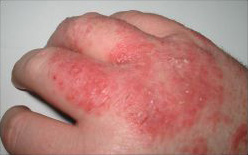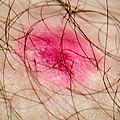Dermatitis facts for kids
Dermatitis is a common skin condition. It means your skin is inflamed, or irritated. When you have dermatitis, your skin might look red, swollen, and feel itchy. Sometimes it can even be dry and flaky. Many people know dermatitis by another name: eczema. It's not contagious, so you can't catch it from someone else.
Contents
What is Dermatitis?
Dermatitis is a general term. It describes a group of skin conditions. All of them cause your skin to become red and swollen. This happens because your body's immune system reacts. It's like an alarm going off in your skin. This alarm causes the redness and itching you see.
Common Signs of Dermatitis
When someone has dermatitis, they usually notice a few things:
- Redness: The skin often turns pink or red.
- Itching: This is a very common symptom. The itch can be mild or very strong.
- Swelling: The affected skin might look a bit puffy.
- Dryness: The skin can become very dry and flaky.
- Blisters: Sometimes small, fluid-filled bumps appear. These can break open.
- Crusting: After blisters break, the skin might form a crust.
- Thickening: If dermatitis lasts a long time, the skin can get thick. It might also look leathery.
Different Types of Dermatitis
There are several kinds of dermatitis. Each type has its own triggers. Knowing the type helps doctors treat it.
Atopic Dermatitis (Eczema)
This is the most common type. It often starts in childhood.
- What it is: It's a long-term condition. It makes your skin very dry and itchy.
- Where it appears: Rashes often show up on the face, inside elbows, and behind knees.
- Causes: It's linked to genetics. It often runs in families. People with atopic dermatitis might also have asthma or hay fever.
- Triggers: Things like dry air, certain soaps, or even stress can make it worse.
Contact Dermatitis
This type happens when your skin touches something. That something causes a reaction.
- What it is: An itchy rash appears where your skin touched a substance.
- Two main kinds:
- Irritant contact dermatitis: This happens when your skin touches something that damages it. Examples include strong soaps, detergents, or chemicals.
- Allergic contact dermatitis: This is an allergic reaction. Your immune system reacts to a substance. Common allergens include poison ivy, nickel (found in jewelry), or certain perfumes.
- Symptoms: The rash can be red, itchy, and sometimes blistery.
Seborrheic Dermatitis
This type mainly affects oily areas of the body.
- What it is: It causes red skin and flaky scales.
- Where it appears: It's common on the scalp, face (especially around the nose and eyebrows), and chest.
- In babies: When babies get it on their scalp, it's called "cradle cap."
- Causes: It's thought to be linked to a type of yeast that lives on the skin. Stress or cold weather can make it worse.
What Causes Dermatitis?
The exact cause of dermatitis can vary. It's often a mix of things.
- Genetics: Some people are born with a higher chance of getting dermatitis. It can run in families.
- Immune System: Your body's defense system can sometimes overreact. This causes inflammation in the skin.
- Environment: Things around you can trigger dermatitis. This includes allergens like pollen or pet dander. It also includes irritants like harsh soaps or chemicals.
- Skin Barrier: Your skin has a protective barrier. If this barrier is weak, it can let irritants in. This makes your skin more sensitive.
How is Dermatitis Treated?
Treating dermatitis often involves managing symptoms. It also means avoiding triggers.
- Moisturizers: Keeping skin hydrated is key. Special creams or lotions help repair the skin barrier.
- Topical Creams: Doctors might prescribe creams. These often contain corticosteroids. They help reduce redness and itching.
- Antihistamines: These medicines can help with itching. They are often taken by mouth.
- Avoiding Triggers: Identifying what makes your dermatitis worse is important. Then you can try to avoid those things. This might mean using mild soaps or wearing gloves.
- Wet Wraps: For severe cases, wet bandages can be used. They help soothe the skin and keep it moist.
- Light Therapy: Sometimes, special light treatments are used. They can help reduce inflammation.
Living with dermatitis can be challenging. But with the right care, symptoms can be controlled. Many people find ways to manage their condition well.
Images for kids
See also
 In Spanish: Dermatitis para niños
In Spanish: Dermatitis para niños





